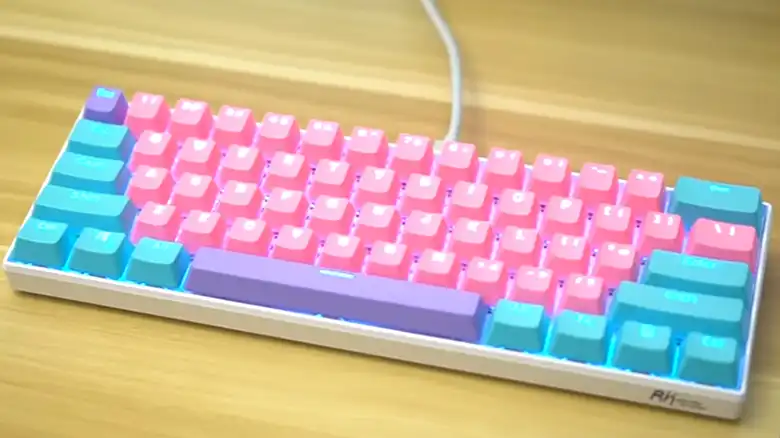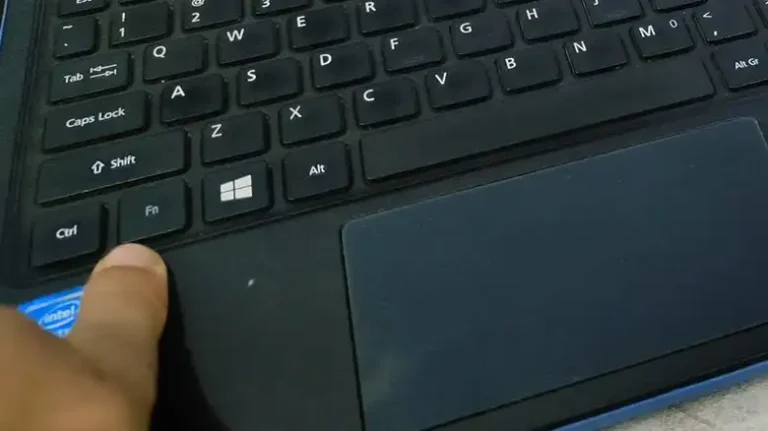How to Tell if Keycaps Are PBT? A Guide for Identification
Have you ever wondered if the keycaps on your mechanical keyboard are high-quality PBT or standard ABS plastic? As a keyboard user myself, I’ve learned to recognize subtle differences in textures, acoustics, and durability between materials that impact the overall typing experience.
Knowing whether your existing keycaps are PBT (Polybutylene Terephthalate) or ABS (Acrylonitrile Butadiene Styrene) allows you to determine if an upgrade would provide any benefit. This guide will explore visual, audial, and manufacturer methods for identifying keycap compositions.
In this quick guide, I’ll share insider techniques to easily identify your keycaps’ plastic-type at a glance.

Check the Appearance of the Keycaps
Carefully examining your keycaps’ appearance provides clues into whether they’re made of PBT or ABS:
Texture: PBT Keycaps Feel Slightly Textured or Grainy
Due to PBT plastic’s more matte finish, PBT keycaps have a subtle grainy or sandy texture to them. In contrast, ABS keycaps tend to feel very smooth, almost waxy.
Rub the surface of a keycap with your finger. PBT keycaps provide noticeable friction from their textured surface.
This textured finish also makes PBT keycaps more resistant to developing shine or becoming smooth and glossy over time. Which brings us to the next distinguishing appearance factor…
Shine: PBT Keycaps Have a Matte Finish, While ABS Keycaps Have a Glossy Finish
Brand new PBT and ABS keycaps may look identical at first glance. But after a few months of use, ABS will develop visible shine or smoothing in frequently used areas like the A, S, and D keys. This results from the natural oils in your fingers slowly wearing down the surface every time you press a key.
PBT plastic has a more textured matte finish that resists this effect much longer. Some enthusiasts report hardly any shine on their PBT sets after years of heavy use.
So if there’s visible glossing on your most frequently pressed keys, there’s a good chance those keycaps are made from ABS plastic. The presence or absence of shine can help confirm what you felt from the keycaps’ texture as well.
Thickness: PBT Keycaps Are Generally Thicker Than ABS Keycaps
While not universally true, PBT keycaps tend to be thicker than typical ABS sets – usually around 1.5mm vs 1mm average thickness respectively.
This extra sturdiness and heft contribute to PBT’s reputation for durability. But it also literally makes individual keycaps feel heavier when removed from the keyboard.
Compare the thickness and weight of keycaps from different sections of your keyboard. Unless you’ve purchased specialty ABS sets marketed as double shot, the thicker, heavier keycaps likely indicate PBT material.
Printing: PBT Keycaps Have Dye-Sublimated Legends, While ABS Keycaps May Have Pad-Printed Legends
Keycap legends refer to the printed symbols and characters on each key indicating its function. The printing technique used for the legends provides another indication on material type.
Due to properties of the plastic, PBT keycaps typically use a dye-sublimation or “dye-sub” print process. This permanently infuses the ink beneath the keycap’s surface for enhanced durability and longevity.
ABS keycaps more often use pad-printing. This essentially “stamps” ink onto the keycap vs infusing it. Pad-printed legends may deteriorate or fade more quickly with heavy use over time.
Examine the quality of your keycap prints up close – crisp, durable dye-sub legends likely signify PBT, while cracking or faded stamps indicate ABS.
Listen to the Sounds Generated by the Keycaps
Believe it or not, the type of plastic used in keycaps impacts the sound signature produced when typing. So take some time to really listen to the sounds of your keyboard.
PBT Keycaps Produce a “Thockier” and Deeper Sound
Due to their thicker construction, PBT keycaps emphasize the lower frequencies as you type. This creates a thockier, more muted tone compared to ABS. Think deeply resonant vs sharp and clicky.
It’s a subtle acoustic effect, but noticeable when actively listening to the sounds as you write paragraphs or code. See if you detect a deeper, almost muted quality to the sound profile.
ABS Keycaps Produce a Higher-Pitched, Louder Sound Signature
That thinner, lighter ABS plastic accentuates higher pitches as keys bottom out. So in general, typing on ABS keycaps results in a higher-pitched, louder tone with more “pop” to each keystroke.
Pay attention to the attack and decay of each keypress. Do you hear slightly thinner, clickier sounds, almost reminiscent of a membrane keyboard? If so, those keycaps likely use ABS.
Additional Methods for Identifying PBT Keycaps
The tips above should help accurately identify your keycaps’ plastic type. But for further confirmation, try the additional methods below:
Consult Manufacturer or Retailer Information
Reputable brands specify the materials used in their keyboards and components. So check the documentation or customer support info to see if they state outright whether PBT or ABS keycaps are used.
Some product listings also indicate this, though double-check to ensure accuracy.
Use a Flame Test (Not Recommended Due to Potential Damage)
It’s not recommended to attempt this high-risk method… But as a last resort, PBT and ABS keycaps burn differently when exposed to flame.
PBT plastic chars and burns slowly with a strong, nasty smell. ABS combusts quickly into a hotter flame while giving off a headache-inducing styrene odor.
Again, exposing keycaps to an open flame risks permanent damage. But if you have defective caps you plan on replacing anyway, analyzing burn patterns provides definitive proof of material types.
How to Know the Pbt Keycaps Are Single Shot or Double Shot?
Determining whether PBT keycaps are single-shot or double-shot involves examining their physical characteristics and legends. Here’s a step-by-step guide:
Inspect the Legend Clarity Hold the keycap up to a light source and observe the legend. If the legend appears sharp, crisp, and well-defined, it’s likely a double-shot keycap. Single-shot legends may have slightly blurry or faded edges due to the printing process.
Examine the Legend Thickness Observe the legend from the side of the keycap. If the legend appears to be a separate layer embedded within the keycap, it’s a double-shot keycap. Single-shot legends may appear thinner or more translucent.
Check for Color Variation If the keycap has multiple colors, examine the transition between colors. Double-shot keycaps will have a distinct separation between colors, while single-shot keycaps may have a slight blending or unevenness.
Consider the Manufacturing Process If you have access to information about the keycap manufacturing process, double-shot keycaps are typically produced using injection molding, while single-shot keycaps may utilize pad printing or laser etching methods.
Consult Product Specifications If available, refer to the product specifications or manufacturer’s website to determine the keycap manufacturing process. This can provide definitive confirmation of whether the keycaps are single-shot or double-shot.
In Summary
PBT and ABS keycaps vary in subtle ways noticeable mainly to discerning keyboard veterans. But understanding your existing plastic-type helps ensure you’re optimizing both cosmetic durability and typing comfort over your keyboard’s lifetime. For hardcore enthusiasts like myself, the textured feel, muted acoustic profile and enduring matte finish make thick PBT keycaps the ultimate endgame material. If you think your ABS keycaps are losing their luster after prolonged use, trust an expert and consider upgrading to doubleshot PBT!
Questions You May Ask
Is it bad if my mechanical keyboard has ABS keycaps?
No, ABS keycaps are perfectly functional and ship as the default option on many quality mechanical keyboards. They only start to suffer cosmetic issues like shining after years of heavy use. They just generally don’t stand up to extreme long-term wear as well as thick PBT keycaps.
Can I replace the ABS keycaps on my mechanical keyboard?
Absolutely! Most mechanical keyboards with a standard layout support replacing the default ABS keycaps with PBT alternatives you prefer, whether for improved durability, custom colors or aesthetics. Just double check “keycap compatibility” before finalizing any replacement set purchases.
Why do people like PBT keycaps so much?
Enthusiasts love PBT plastic for its textured finish that resists shining, thick and durable construction, and its ability to retain a brand new appearance even after extremely heavy long-term use. PBT keycaps basically represent the “end game” material for demanding typists.
How thick should good PBT keycaps be?
Look for PBT keycap sets around 1.5mm thickness, sometimes advertised as “double shot”. Thinner PBT sets down to around 1.2mm also offer durability improvements over standard ABS, but that extra heft really maximizes the resilience and lifespan of the nicest PBT sets.
![[Explained] Can You Remove the Keycaps on the Logitech G213?](https://keyboardhunter.com/wp-content/uploads/2023/10/Can-You-Remove-the-Keycaps-on-the-Logitech-G213-768x431.webp)
![[Explained] Can You Clean Keycaps with Isopropyl Alcohol?](https://keyboardhunter.com/wp-content/uploads/2023/10/Can-You-Clean-Keycaps-with-Isopropyl-Alcohol-768x431.webp)

![[Easy Explanation] Can You Put Mechanical Keycaps on A Membrane Keyboard?](https://keyboardhunter.com/wp-content/uploads/2023/06/Can-You-Put-Mechanical-Keycaps-on-A-Membrane-Keyboard-768x431.webp)
![[Fixed] Mute Button on Keyboard Not Working](https://keyboardhunter.com/wp-content/uploads/2023/10/Mute-Button-On-Keyboard-Not-Working-768x431.webp)
![[Explained] Do PBT Keycaps Get Dirty?](https://keyboardhunter.com/wp-content/uploads/2023/02/Do-PBT-Keycaps-Get-Dirty-768x431.webp)